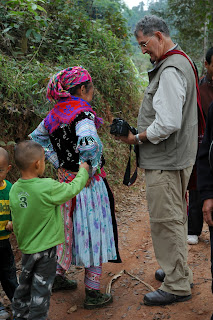 |
| Culture contact - what its all about |
From February 2nd to the 9th we went on a road trip co-guiding three ethnic Thai Lue to visit rural areas of Xipsongpanna in China as well as tribal villages along Route 3 in Northwestern Laos. The highlight of our adventure was staying 6 nights in Bohae, Xipsongpanna the Southern most prefecture of Yunnan Province. Here we were able to closely observe and participate in daily village life and learn of the ongoing changes as China modernizes.
We crossed the Thai Laotian border at Chiang Khong and headed out for an approximate 5 hour van ride to the Chinese border at Boten. The road was paved and much improved since last transiting the route in the mid 1990's which required our 4 wheel drive and the occasional help of local villagers to get us out of various predicaments. Route 3 is a part of the Chinese plan to have a direct link to Bangkok and its port facilities.
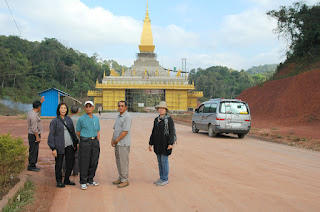 |
| Lao side of border at Boten |
Along this road are situated various villages most of which have been relocated from more remote areas in a government program not without controversy. Villages include those inhabited by Khmu, Lamet, Lanten and other groups. The area around the towns of Viengphukha and Luang Namtha witnessed heavy fighting during the Vietnam War era. We plan to further explore this area and attend Khmu wedding ceremonies of friends in the last week of March.
 |
| All dressed up, Yuan kids near Luang Namtha, Laos |
 |
| Yuan weaving |
 |
| Yuan elder |
We were impressed at the border with the modernity, efficiency and politeness of the Chinese immigration and customs formalities. Modern scanning equipment obviated the need for lengthy form filling and the English speaking officials were polite and helpful. As we crossed the border late we were fortunate to catch the last bus heading for Mengla which was willing to stop at Bohae. The dual lane well signed road had only been recently completed and wound its way through mountainous terrain which was mostly covered with rubber plantations. Unfortunately it wasnt door to door bus service and we were dropped by the roadside to fend for ourselves. So in the end we entered the village in small tractor powered farm vehicles.
 |
| Chinese border crossing at Mohan |
 |
| Our entry into the village |
 |
| Village of Bohae, Xipsongpanna, Yunnan, China |
Our hosts in the village were friends and relatives of Lue friends who had moved to Laos and who eventually with the collapse of the Royal Lao government fled to Thailand as refugees and who ultimately were resettled in America. The village for the most part consisted of traditional Lue style houses built on stilts. The houses were large, made of wood with small ceramic roof tiles. More modern versions had newer roofing materials, usually blue in color or occasionally they departed from traditional designs and materials and consisted of blockish cement structures. Houses were closely spaced with access by small walkways.
 |
| Sermsri with hosts Mr. and Mrs. Bo Xiang Dan and daughters |
 |
| Typical large wooden Lue house |
 |
| Roof lines in Bohae |
Most houses had vehicles parked underneath, cars or pickups or at the least a farm tractor. Television was
near ubiquitous as were personal mobile phones and solar hot water heaters. Women tended to wear their hair in traditional style but the dress was more Western for the men and Chinese for the women. Some small scale weaving of traditional scarves and face cloths was done by women on small looms located under the houses. The under house areas were also used for storage and some livestock raising though pigs were generally kept in small cement structures somewhat removed from the house.
 |
| Typical Lue womens hairstyles and dress |
 |
| Lue weaving loom |
 |
| Lue weaving |
Vegetable gardens and fish ponds were located around the periphery of the village. The usual economic and subsistence pursuit is wet rice farming, however, most of the village land had been leased out for contract banana farming. In the end the villagers are dissatisfied with this arrangement as the land rental fees are small and the wages for laboring in the plantations low. Hence it is doubtful if the village will renew this kind of arrangement. Other economic activities include the growing of rubber and tea in the distant mountains.
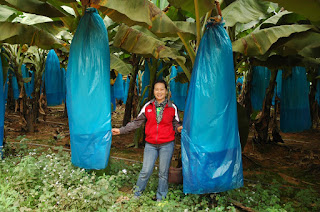 |
| Sermsri in banana plantation |
 |
| Multilayer protective covering over banans |
 |
| Mountainside tea plantation |
 |
| Spreading tea leaves to dry |
The village which was relocated some years ago owing to a fire having destroyed the previous site did have a new temple which was built with local funds and monies donated from Lue in the USA. There were no monks in full time residence as was the case in many of the temples we visited. The cultural revolution of several decades ago outlawed religious activities and many temples and cultural treasures were destroyed. Hence, the reestablishment of traditional village religious activities is taking time to reestablish. Unfortunately many fine old wood temples are being removed and replaced with more modern concrete based structures.
 |
| Ancient wooden Lue temple |
 |
| Modern temple at Bohae |
Our stay in the village was marked by the overwhelming friendliness and generosity of the villagers and it was impossible to keep up with the many invitations to sleep and eat at various houses.From the village we hiked and drove to nearby Hmong, Lahu and Mien villages each distinct in their own way. The Hmong and Mien in particular were fond of being photographed in their best finery. It was interesting to learn about the inter country communication taking place via trade, visiting and migration often on foot.
 |
| Preparing vegetables for evening party |
 |
| Enjoying dinner with new friends |
 |
| Delicious fresh food at every meal |
 |
| Dance performance put on for us by Bohae villagers |
 |
| Even the men got in on the fun |
 |
| Lahu house |
 |
| Lahu woman with the right message |
 |
| Young Hmong woman in her finery |
 |
| Hmong villagers |
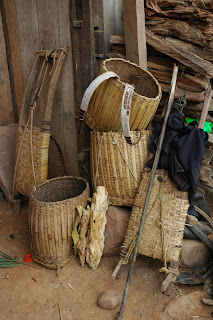 |
| Hmong baskets and backpacks |
 |
| A pensive youngster |
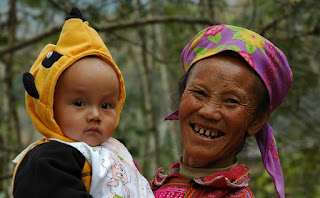 |
| Met on trail near Bohae |
 |
| A fun encounter |
 |
| A young Mien woman in her Sunday best |
 |
| Mien womens pants with cross stitch designs |
 |
| Mien elder |
We enjoyed seeing large tracts of pristine jungle which is well known as the home of many species of plants and animals. Bears, tigers and wild pigs can still be spotted. Such animals have pretty well been hunted out in the forests of neighboring Laos and Burma as well as Thailand.
Our trip also included trips to Mengla and the capitol of Xipsongpanna - Jinghong. Both were modern in outlook and being overwhelmed with massive amounts of new construction which included government buildings, hotels and shopping centers. The larger supermarkets carry a wide range of goods including various foreign brands. KFC and McDonalds were present in Jinghong though we preferred the local eateries chosen by our local friends. Boutiques selling the latest fashions abounded. Womens fashion was marked by short skirts over leggings or pants and high heeled boots.
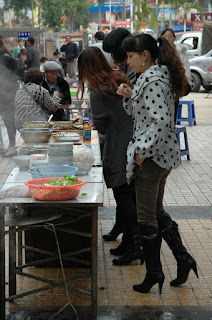 |
| In the big cities everyone seemed to wear the latest styles |
 |
| East meets West in Mengla |
As it was Chinese New Year a steady stream of traffic was headed to the Laotian border town of Boten where the Chinese have leased a large area of land and established a large incongruous casino and hotel complex which has been the subject of much comment and concern.
The pictures above provide a visual sample of the sights we experienced. We at Lanna Thai Villa are happy to facilitate travel and guide guests to new and different destinations which emphasizes culturally sensitive interaction with the many interesting peoples which inhabit the region. Whether interested in weaving, photography, hiking or just experiencing new and different peoples we are ready to help you realize your goals. We end this blog post with pictures of some of the many young smiling faces we encountered.














